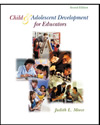 |  Child and Adolescent Development for Educators, 2/e Judith Meece,
University of North Carolina - Chapel Hill
Student Study Guide by Nancy Defrates-Densch
Book Preface| My decision to write Child and Adolescent Development for Educators was inspired by a desire to create positive school environments for children and adolescents. Young people spend over 15,000 in some form of school setting. Research now shows that the experiences and interactions they have in those settings have a lasting influence on almost every aspect of their development. Moreover, for many young people today, schools play an influential role in protecting them from the adverse effects of poverty, dangerous neighborhoods, or difficult home environments.
My decision to write a development text for educators also grows out of my work as a teacher educator and researcher. I have over 20 years of experience teaching child and adolescent development courses to education students. Until my first edition was published, I relied on child and adolescent texts written for psychology students. Although there are many fine texts available, few focus on children’s development in school settings. As a educational researcher, I was aware of a growing research literature on the effects of schools on child and adolescent development, and the many ways this research may be applied in educational settings. Thus, I wrote the first edition of Child and Adolescent Development for Educators with the idea of designing a text appropriate for educators but including a strong research base on schooling and development. Most importantly, I wanted to write a development text that would reflect the important role of teachers and schools in children’s lives. It was the first book of this type in education.OVERALL APPROACH – A DEVELOPMENT TEXT FOR FUTURE TEACHERS
Child and Adolescent Development for Educators is a text written for teachers. It presents the content future teachers need to know in order to understand the development of their students. From its inception, this book was designed to meet the special needs of teacher education students. For example, in addition to focusing exclusively on school-age development, each chapter opens with a school or classroom vignette that sets the stage for the material that follows and then punctuates each discussion with an abundance of school and classroom examples. The Focus on Research and Focus on Teaching features show students how to connect and apply developmental research to the classroom, and provide them with extended classroom examples. In addition, each chapter concludes with an assortment of observation, interview, and reflection activities designed to apply key topics. Even topic coverage reflects the realities of teaching, with a third of the text being devoted to cognitive and language development. The importance of social and cultural context on development is also emphasized throughout the bookCOVERAGE AND ORGANIZATION
The text takes a topical approach. The content is focused on those topics of most interest to educators—cognitive development, literacy, social and emotional development, children with special learning needs, and family involvement in education. Because of its teaching focus and modest price, it can be used as a core text with supplemental readings and materials.
The text is organized into nine chapters. Chapter 1 stresses the importance of studying children’s development in education, and provides an overview of the theories and the methods used in child development research. This chapter emphasizes the important role that schools and teachers play in children’s development. Chapter 2 examines children’s physical development, with a focus on brain development, puberty, genetic and environmental risk factors, and special health concerns in childhood and adolescence. A special section discusses the implications of brain research for education. There are two chapters on cognitive development. Chapter 3 focuses on Piaget’s cognitive-development theory and Vygotsky’s sociocultural theory. Both theories serve as the theoretical foundations for constructivist approaches in education. Chapter 4 presents information processing and psychometric approaches to understanding children’s intellectual development, and discusses how individual variations in cognitive development are measured and explained. A special section focuses on the influence of television and computers on children’s learning.
The focus of Chapter 5 is children’s language and literacy development, and new approaches to teaching reading and writing are highlighted. This chapter also contains information on literacy development in non-English speaking children. Chapter 6 presents a comprehensive introduction to the development of children with special learning needs. The chapter is organized according to the prevalence of different exceptionalities in the school population, beginning with high-prevalence conditions such as learning disabilities, communication disorders, attention deficit/hyperactive disorder, and so on. The last three chapters focus on children’s emotional and social development, and the role of the family in development. Chapter 7 addresses the development of emotional competence, conceptions of the self, and motivation. It begins with an overview of Erikson’s theory of psychosocial development, and each section concludes with a set suggestions for how teachers can help foster emotional competence, positive self-conceptions, and academic motivation. Chapter 8 turns to children’s social understanding and relations, focusing on the development of social cognition, peer relations, peer groups, and moral development. The chapter addresses how educators can create a caring and supportive environment that promotes social understanding and acceptance. The final chapter, Chapter 9, is devoted to the important role of the family in children’s development, including a discussion of family diversity and transitions. For educators, it includes important information on child care, helping children cope with divorce, and child maltreatment. Most importantly, the chapter concludes by suggesting some ways educators can form partnerships with parents and other family members.
|
|



 2002 McGraw-Hill Higher Education
2002 McGraw-Hill Higher Education